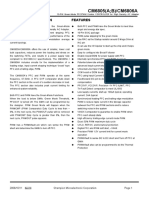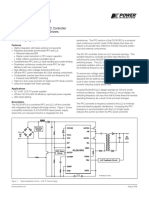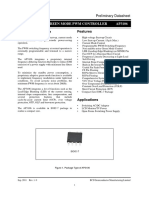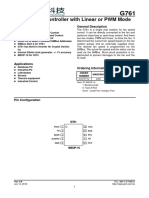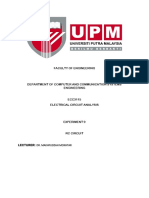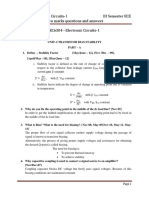R8CB05BO Champion
R8CB05BO Champion
Uploaded by
wwwxxxCopyright:
Available Formats
R8CB05BO Champion
R8CB05BO Champion
Uploaded by
wwwxxxOriginal Title
Copyright
Available Formats
Share this document
Did you find this document useful?
Is this content inappropriate?
Copyright:
Available Formats
R8CB05BO Champion
R8CB05BO Champion
Uploaded by
wwwxxxCopyright:
Available Formats
R8CB05BO
10-PIN Green-Mode PFC/PWM Combo CONTROLLER
GENERAL DESCRIPTION FEATURES
The R8CB05BO is the Green-Mode PFC/PWM Combo 10-Pin SOIC package.
controller for Desktop PC and High Density AC Adapter. Use RAC around 4~8 Mega Ohm at IAC pin.
For the power supply, it’s input current shaping PFC Easy to configure into Boost Follower.
performance could be very close to the performance of the Enable lowest BOM for power supply with PFC.
CM6800 or ML4800 leading edge modulation average Internally synchronized PFC and PWM in one IC.
current topology. Patented slew rate enhanced voltage error amplifier
with advanced input current shaping technique.
R8CB05BO offers the use of smaller, lower cost bulk Universal Line Input Voltage
capacitors, reduces power line loading and stress on the CCM boost or DCM boost with leading edge
switching FETs, and results in a power supply fully modulation PFC using Input Current Shaping
compliant to IEC1000-3-2 specifications. The R8CB05BO Technique.
includes circuits for the implementation of a leading edge Feed forward IAC pin to do the automatic slope
modulation, input current shaping technique “boost” type compensation.
PFC and a trailing edge modulation current, PWM. PFCOVP, Precision -1V PFC ILIMIT, PFC Tri-Fault
Detect comparator to meet UL1950
The R8CB05BO’s PFC and PWM operate at the same Low supply currents; start-up: 100uA typical,
frequency, 100kHz. A PFC OVP comparator shuts down operating current: 2mA typical.
the PFC section in the event of a sudden decrease in load. Synchronized leading PFC and trailing edge
The PFC section also includes peak current limiting for modulation PWM to reduce ripple current in the
enhanced system reliability. storage capacitor between the PFC and PWM
sections and to reduce switching noise in the system
PFC has a PFCOFFB pin which can use for AC brown out VIN-OK Comparator to guarantee to enable PWM
application and determine the GMth to turn off PFC. when PFC reach steady state
High efficiency trailing-edge current mode PWM
Exact 50% PWM maximum duty cycle
UVLO, REFOK, and brownout protection
Digital PFC and PWM soft start, ~10mS
Precision PWM 1.5V current limit for current mode
operation
PFCOFFB pin to sense light load to turn off PFC or
PFCOFFB pin to sense Input voltage as AC Brown
Out
2007/12/18 Rev 1.0 Champion Microelectronic Corporation Page 1
R8CB05BO
10-PIN Green-Mode PFC/PWM Combo CONTROLLER
APPLICATIONS PIN CONFIGURATION
10 Pin SSOP (R10)
Top View
Desktop PC
AC Adaptor
Open Frame
PIN DESCRIPTION
Operating Voltage
Pin No. Symbol Description
Min. Typ. Max. Unit
1 GND Ground
2 IAC Feedforward input to do slope compensation and to start up 0 1 mA
the system. During the start up, IAC is connected to VCC
until VCC is greater than 13V.
3 ISENSE Current sense input to the PFC current limit comparator -5 0.7 V
4 VEAO PFC transconductance voltage error amplifier output 0 6 V
5 VFB PFC transconductance voltage error amplifier input 0 2.5 3 V
6 V+I PWM feed back and current limit comparator input 0 1.5 V
7 PFCOFFB PFCOFFB; it can turn off PFC stage when it is below 5V. 0 VCC V
8 VCC Positive supply 10 15 18 V
9 PFC OUT PFC driver output 0 VCC V
10 PWM OUT PWM driver output 0 VCC V
ORDERING INFORMATION
Part Number Operation Frequency Initial Accuracy (KHz) Temperature Range Package
Min Typ Max
R8CB05BOGIR Fpwm = Fpfc = 100Khz 90 100 110 -40℃ to 125℃ 10 Pin SSOP(R10)
Note:
1. G : Suffix for Pb Free Product
2. Initial Accuracy : TA=25℃
2007/12/18 Rev 1.0 Champion Microelectronic Corporation Page 2
R8CB05BO
10-PIN Green-Mode PFC/PWM Combo CONTROLLER
BLOCK DIAGRAM
2 4
IAC .VEAO
40K IAC 8
VCC
400K S Q
ISENSE
100K R
PFC CMP
3
-
R Q
-
UVB
+
.
SUM + VREFDK 9
V To Ramp PFCOUT
VFB
GMV
5 -
. . . UVLO
+
2.5V
FAULT
VCC . .
BROKENWIRE
-
+
0.5V
PFCCLK PFC CLK fpfc=100KHz
.
PWMCLK
.
PFC OVP
+ PWM CLK
.
2.75V
- VIN-OK S Q
- VFB +
2.5V
. R1
2.25V - UVB
1.1V - R2 Q
VREFDK 10
- PFC ILIMIT PWMOUT
.
+
-1V
PFCOFFB
SHUTDOWN PFC
7 - 10mS
.
5.5V +
+
PWM CMP
5V 1.5V -
PWMCLK . . - 1
SS .
GND
GND
+
SOFT START PROTECTED BY PATENT
6
V+I
ABSOLUTE MAXIMUM RATINGS
Absolute Maximum ratings are those values beyond which the device could be permanently damaged.
Parameter Min. Max. Units
VCC MAX 20 V
IAC (before start up) GND-0.3 VCC + 0.3 V
IAC (after start up) GND-0.3 1.0 V
ISENSE Voltage -5 0.7 V
PFC OUT GND – 0.3 VCC + 0.3 V
PWM OUT GND – 0.3 VCC + 0.3 V
VEAO 0 6.3 V
PFCOFFB GND – 0.3 VCC + 0.3 V
Voltage on Any Other Pin GND-0.3 VCC + 0.3 V
ICC Current (Average) 40 mA
Peak PFC OUT Current, Source or Sink 0.5 A
Peak PWM OUT Current, Source or Sink 0.5 A
PFC OUT, PWM OUT Energy Per Cycle 1.5 μJ
Junction Temperature 150 ℃
Storage Temperature Range -65 150 ℃
Operating Temperature Range -40 125 ℃
Lead Temperature (Soldering, 10 sec) 260 ℃
Thermal Resistance (θJA) 80 ℃/W
2007/12/18 Rev 1.0 Champion Microelectronic Corporation Page 3
R8CB05BO
10-PIN Green-Mode PFC/PWM Combo CONTROLLER
ELECTRICAL CHARACTERISTICS Unless otherwise stated, these specifications apply Vcc=+14V,
TA=Operating Temperature Range (Note 1)
R8CB05BO
Symbol Parameter Test Conditions Unit
Min. Typ. Max.
Voltage Error Amplifier (GMv)
Input Voltage Range 0 5 V
Transconductance VNONINV = VINV, VEAO = 3.75V 30 65 90 μmho
Feedback Reference Voltage 2.41 2.5 2.55 V
Input Bias Current Note 2 -0.5 -1.0 μA
Output High Voltage 5.8 6.0 V
Output Low Voltage 0.1 0.4 V
Sink Current VFB = 3V, VEAO = 6V -35 -10 μA
Source Current VFB = 1.5V, VEAO = 1.5V 30 40 μA
Open Loop Gain 50 60 dB
Power Supply Rejection Ratio 11V < VCC < 16.5V 50 60 dB
IAC
Input Impedance (R8CB05BO) ISENSE = 0V, TA=25℃ 35K 40K 50K Ohm
PFC OVP Comparator
Threshold Voltage 2.62 2.77 2.88 V
Hysteresis 65 150 mV
PFC ILIMIT Comparator
Threshold Voltage -1.1 -1 -0.88 V
Delay to Output 150 300 ns
VIN OK Comparator
Threshold Voltage (R8CB05BO) 2.16 2.26 2.36 V
Hysteresis 1.13 1.17 1.21 V
PWM Digital Soft Start
Digital Soft Start Timer (Note 2) Right After Start Up 10 ms
V + I Comparator
Threshold Voltage Normal operation without soft start 1.38 1.5 1.62 V
Delay to Output (Note 2) 150 300 ns
Threshold Voltage During soft start condition 100 150 200 mV
PFC Tri-fault
Fault Detect HIGH 2.70 2.77 2.85 V
VFB=VFAULT DETECT LOW to VFB = OPEN,
Time to Fault Detect HIGH 2 4 ms
470pF from VFB to GND
Fault Detect LOW 0.4 0.5 0.6 V
2007/12/18 Rev 1.0 Champion Microelectronic Corporation Page 4
R8CB05BO
10-PIN Green-Mode PFC/PWM Combo CONTROLLER
ELECTRICAL CHARACTERISTICS Unless otherwise stated, these specifications apply Vcc=+14V,
TA=Operating Temperature Range (Note 1)
R8CB05BO
Symbol Parameter Test Conditions Unit
Min. Typ. Max.
PFCOFFB
PFCOFFB Threshold Low PFCOFFB 4.75 5.0 5.25 V
PFCOFFB Hysteresis 350 500 750 mV
PFC Frequency
Voltage Stability 10V < VCC < 15V 1 %
Temperature Stability 2 %
Total Variation Line, Temp (R8CB05BO) 90 100 110 kHz
PFC Dead Time (Note 2) 0.3 0.45 0.65 us
PFC
Minimum Duty Cycle IAC=100uA,VFB=2.55V, ISENSE = 0V 1 %
Maximum Duty Cycle IAC=0uA,VFB=2.0V, ISENSE = 0V 90 95 %
Output Low Rdson 15 22.5 ohm
IOUT = -100mA 0.8 1.5 V
Output Low Voltage
IOUT = -10mA, VCC = 8V 0.4 0.8 V
Output High Rdson 30 45 ohm
Output High Voltage IOUT = 100mA, VCC = 15V 13.5 14.2 V
Rise/Fall Time (Note 2) CL = 1000pF 50 ns
PWM
Duty Cycle Range IC 49 49.5 50 %
Output Low Rdson At room temp 15 22.5 ohm
IOUT = -100mA 0.8 1.5 V
Output Low Voltage
IOUT = -10mA, VCC = 8V 0.7 1.5 V
Output High Rdson (Note 2) At room temp 30 45 ohm
Output High Voltage IOUT = 100mA, VCC = 15V 13.5 14.2 V
Rise/Fall Time (Note 2) CL = 1000pF 50 ns
Supply
Start-Up Current VCC = 11V, CL = 0 135 150 uA
Operating Current VCC = 15V, CL = 0 2 4 mA
Undervoltage Lockout Threshold 12.35 13 13.65 V
Undervoltage Lockout Hysteresis 2.7 3 3.3 V
Note 1: Limits are guaranteed by 100% testing, sampling, or correlation with worst-case test conditions.
Note 2: Guaranteed by design, not 100% production test.
2007/12/18 Rev 1.0 Champion Microelectronic Corporation Page 5
R8CB05BO
10-PIN Green-Mode PFC/PWM Combo CONTROLLER
TYPICAL PERFORMANCE CHARACTERISTIC
127
120
Transconductance (umho)
113
106
99
92
85
78
71
64
57
2 2.1 2.2 2.3 2.4 2.5 2.6 2.7 2.8 2.9 3
VFB (V)
Voltage Error Amplifier (GMv) Transconductance
2007/12/18 Rev 1.0 Champion Microelectronic Corporation Page 6
R8CB05BO
10-PIN Green-Mode PFC/PWM Combo CONTROLLER
Functional Description
Detailed Pin Descriptions
The R8CB05BO consists of an ICST (Input Current IAC (Pin 2)
Shaping Technique), CCM (Continuous Conduction Mode) Typically, it has a feed-forward resistor, RAC,
or DCM (Discontinuous Conduction Mode) boost PFC 4Mega~10Mega ohm resistor connected between this pin
(Power Factor Correction) front end and a synchronized and rectified line input voltage.
PWM (Pulse Width Modulator) back end. The R8CB05BO The current of RAC will program the automatic slope
is designed to replace FAN4803 (8 pin SOP package), compensation for the system. This feed-forward signal can
which is the second generation of the ML4803 with 8 pin increase the signal to noise ratio for the light load condition
package. It is distinguished from earlier combo controllers or the high input line voltage condition.
by its low count, innovative input current shaping technique,
and very low start-up and operating currents. The PWM ISENSE (Pin 3)
section is dedicated to peak current mode operation. It uses This pin ties to a resistor which senses the PFC input
conventional trailing-edge modulation, while the PFC uses current. This signal should be negative with respect to the IC
leading-edge modulation. This patented Leading ground. It internally feeds the pulse-by-pulse current limit
Edge/Trailing Edge (LETE) modulation technique helps to comparator and the current sense feedback signal. The
minimize ripple current in the PFC DC bus capacitor. ILIMIT trip level is –1V. The ISENSE feedback is internally
multiplied by a gain of four and compared against the internal
The main improvements from ML4803 are: programmed ramp to set the PFC duty cycle. The
1. Add Green Mode Functions for both PFC and PWM intersection of the boost inductor current down-slope with the
2. Remove the one pin error amplifier and add back the internal programming ramp determines the boost off-time.
slew rate enhancement GMv, which is using voltage
input instead of current input. This transconductance It requires a RC filter between ISENSE and PFC boost
amplifier will increase the transient response 5 to 10 sensing resistor.
times from the conventional OP
3. VFB PFC OVP comparator VEAO (Pin 4)
4. PFC Tri-Fault Detect for UL1950 compliance and
This is the PFC slew rate enhanced transconductance
enhanced safety
amplifier output which needs to connected with a
5. A feed forward signal from IAC pin is added to do the
automatic slope compensation. This increases the compensation network Ground.
signal to noise ratio during the light load; therefore,
THD is improved at light load and high input line VFB (Pin 5)
voltage. Besides this is the PFC slew rate enhanced
6. R8CB05BO does not require the bleed resistor and it transconductance input, it also tie to a couple of protection
uses the more than 800k ohm resistor between IAC comparators, PFCOVP, and PFC Tri-Fault Detect
pin and rectified line voltage to feed the initial current
before the chip wakes up. V + I (Pin 6)
7. VIN-OK comparator is added to guaranteed PWM This pin is tied to the primary side PWM current sense
cannot turn on until VFB reaches 2.5V in which PFC resistor or transformer. It provides the internal pulse-by-pulse
boost output is about steady state, typical 380V. current limit for the PWM stage (which occurs at 1.5V) and
8. A 10mS digital PWM soft start circuit is added the peak current mode feedback path for the current mode
9. 10 pin SOP package control of the PWM stage. Besides current information, the
10. No internal Zener and VCCOVP comparator photo-couple also goes into V + I pin. Therefore, it is the
SUM Amplifier input.
The R8CB05BO operates both PFC and PWM sections at Soft Start is around 10mS after the startup(VCC is greater
100kHz. This allows the use of smaller PWM magnetic and than 13V).
output filter components, while minimizing switching losses
in the PFC stage.
Several protection features have been built into the
R8CB05BO. These include soft-start, redundant PFC
overvoltage protection, PFC Tri-Fault Detect, VIN-OK, peak
current limiting, duty cycle limiting, under-voltage lockout,
reference ok comparator and PFCOFFB.
2007/12/18 Rev 1.0 Champion Microelectronic Corporation Page 7
R8CB05BO
10-PIN Green-Mode PFC/PWM Combo CONTROLLER
PFCOFFB (Pin 7) PFCOUT (Pin 9) and PWM OUT (Pin 10)
When this pin is below 5V, PFC gate drive, PFCOUT will be PFC OUT and PWM OUT are the high-current power driver
turned off until PFCOFFB pin is greater than 5.5V. When capable of directly driving the gate of a power MOSFET with
PFCOFFB is below 5V, Veao also been pulled low as well. peak currents up to -1A and +0.5A. Both outputs are actively
held low when VCC is below the UVLO threshold level which
PFCOFFB usually is used for AC Brown Out. is 15V or VREFOK comparator is low.
For AC Brown out, PFCOFFB can be used to sense the
Power Factor Correction
bridge input voltage.
Power factor correction makes a nonlinear load look like a
When PFCOFFB is below 5V, PFC can be turned off.
resistive load to the AC line. For a resistor, the current drawn
VCC (Pin 8) from the line is in phase with and proportional to the line
voltage, so the power factor is unity (one). A common class
VCC is the power input connection to the IC. The VCC
of nonlinear load is the input of most power supplies, which
start-up current is 100uA. The no-load ICC current is 2mA.
use a bridge rectifier and capacitive input filter fed from the
VCC quiescent current will include both the IC biasing
line. The peak-charging effect, which occurs on the input
currents and the PFC and PWM output currents. Given the
operating frequency and the MOSFET gate charge (Qg), filter capacitor in these supplies, causes brief high-amplitude
pulses of current to flow from the power line, rather than a
average PFC and PWM output currents can be calculated
sinusoidal current in phase with the line voltage. Such
as IOUT = Qg x F. The average magnetizing current
required for any gate drive transformers must also be supplies present a power factor to the line of less than one
(i.e. they cause significant current harmonics of the power
included. The VCC pin is also assumed to be proportional
line frequency to appear at their input). If the input current
to the PFC output voltage. VCC also ties internally to the
drawn by such a supply (or any other nonlinear load) can be
UVLO circuitry and VREFOK comparator, enabling the IC at
made to follow the input voltage in instantaneous amplitude,
13V and disabling it at 10V. VCC must be bypassed with a
it will appear resistive to the AC line and a unity power factor
high quality ceramic bypass capacitor placed as close as
possible to the IC. Good bypassing is critical to the proper will be achieved.
operation of the R8CB05BO.
To hold the input current draw of a device drawing power
VCC is typically produced by an additional winding off the from the AC line in phase with and proportional to the input
voltage, a way must be found to prevent that device from
boost inductor or PFC Choke, providing a voltage that is
loading the line except in proportion to the instantaneous line
proportional to the PFC output voltage. An external clamp,
such as shown in Figure 1, is desirable and proposed to voltage. The PFC section of the R8CB05BO uses a
boost-mode DC-DC converter to accomplish this. The input
limit VCC over voltage to an acceptable value.
to the converter is the full wave rectified AC line voltage. No
VCC
bulk filtering is applied following the bridge rectifier, so the
input voltage to the boost converter ranges (at twice line
frequency) from zero volts to the peak value of the AC input
and back to zero.
By forcing the boost converter to meet two simultaneous
1N 5248 conditions, it is possible to ensure that the current draws
from the power line matches the instantaneous line voltage.
One of these conditions is that the output voltage of the
boost converter must be set higher than the peak value of
the line voltage. A commonly used value is 385VFB, to allow
for a high line of 270VACrms. The other condition is that the
GND current that the converter is allowed to draw from the line at
any given instant must be proportional to the line voltage.
Figure1 . Optional VCC Clamp
This limits the maximum VCC that can be applied about
18V to avoid OVP which allowing to the VCC maximum
rating. An RC filter at VCC is required between boost trap
winding and VCC.
2007/12/18 Rev 1.0 Champion Microelectronic Corporation Page 8
R8CB05BO
10-PIN Green-Mode PFC/PWM Combo CONTROLLER
PFC Control: Leading Edge Modulation with Input Therefore, equation (6) becomes:
Current Shaping Technique I d × toff
(I.C.S.T.) Id = = I d × d ' = I d × (1 − d ) (7)
Tsw
The only differences between the conventional PFC control
topology and I.C.S.T. is: Combine equation (7) and equation (5), and we get:
the current loop of the conventional control method is a ( d ' ) 2 × Vout
close loop method and it requires a detail understanding Id × d ' =
Re
about the system loop gain to design. With I.C.S.T., since
the current loop is an open loop, it is very straightforward to d × Vout
'
implement it. ∴ Id = (8)
Re
The end result of the any PFC system, the power supply is Vout toff
like a pure resistor at low frequency. Therefore, current is in ∴ Id = ×
phase with voltage.
Re Tsw
In the conventional control, it forces the input current to
follow the input voltage. In R8CB05BO, the chip thinks if a From this simple equation (8), we implement the PFC control
boost converter needs to behave like a low frequency section of the R8CB05BO
resistor, what the duty cycle should be.
Leading/Trailing Modulation
The following equations is R8CB05BO try to achieve: Conventional Pulse Width Modulation (PWM) techniques
employ trailing edge modulation in which the switch will turn
ON right after the trailing edge of the system clock. The error
Vin
Re = (1) amplifier output is then compared with the modulating ramp.
I in When the modulating ramp reaches the level of the error
amplifier output voltage, the switch will be turned OFF. When
I l = I in (2) the switch is ON, the inductor current will ramp up. The
effective duty cycle of the trailing edge modulation is
determined during the ON time of the switch. Figure 2 shows
Equation 2 means: average boost inductor current equals a typical trailing edge control scheme.
to input current.
∴Vin × I l ≈ Vout × I d (3) In case of leading edge modulation, the switch is turned OFF
Therefore, input instantaneous power is about to equal to right at the leading edge of the system clock. When the
the output instantaneous power. modulating ramp reaches the level of the error amplifier
output voltage, the switch will be turned ON. The effective
For steady state and for the each phase angle, boost duty-cycle of the leading edge modulation is determined
converter DC equation at continuous conduction mode is: during OFF time of the switch. Figure 3 shows a leading
edge control scheme.
Vout
= 1 (4)
Vin (1 − d )
Rearrange above equations, (1), (2),(3), and (4) in term of
Vout and d, boost converter duty cycle and we can get
average boost diode current equation (5):
(1 − d ) 2 × Vout
Id = (5)
Re
Also, the average diode current can be expressed as:
1 Toff
Id =
Tsw ∫0
I d (t ) ⋅ dt (6)
If the value of the boost inductor is large enough, we can
assume I d (t ) ~ I d . It means during each cycle or we
can say during the sampling, the diode current is a
constant.
2007/12/18 Rev 1.0 Champion Microelectronic Corporation Page 9
R8CB05BO
10-PIN Green-Mode PFC/PWM Combo CONTROLLER
One of the advantages of this control technique is that it ZCV: Compensation Net Work for the Voltage Loop
required only one system clock. Switch 1(SW1) turns OFF GMv: Transconductance of VEAO
and switch 2 (SW2) turns ON at the same instant to PIN: Average PFC Input Power
minimize the momentary “no-load” period, thus lowering VOUTDC: PFC Boost Output Voltage; typical designed value is
ripple voltage generated by the switching action. With such 380V.
synchronized switching, the ripple voltage of the first stage CDC: PFC Boost Output Capacitor
is reduced. Calculation and evaluation have shown that the
120Hz component of the PFC’s output ripple voltage can be ΔVEAO: This is the necessary change of the VEAO to deliver
reduced by as much as 30% using this method, the designed average input power. The average value is
substantially reducing dissipation in the high-voltage PFC 6V-3V=3V since when the input line voltage increases, the
capacitor. delta VEAO will be reduced to deliver the same to the output.
To over compensate, we choose the delta VEAO is 3V.
Typical Applications
PFC Section: Internal Voltage Ramp
PFC Voltage Loop Error Amp, VEAO The internal ramp current source is programmed by way of
The ML4803 utilizes an one pin voltage error amplifier in VEAO pin voltage. When VEAO increases the ramp current
the PFC section (VEAO). In the R8CB05BO, it is using the source is also increase. This current source is used to
slew rate enhanced transconductance amplifier, which is develop the internal ramp by charging the internal 30pF +12/
the same as error amplifier in the CM6800. The unique -10% capacitor. The frequency of the internal programming
transconductance profile can speed up the conventional ramp is set internally to 100kHz.
transient response by 10 times. The internal reference of
the VEAO is 2.5V. The input of the VEAO is VFB pin. Design PFC ISENSE Filtering
ISENSE Filter, the RC filter between Rs and ISENSE:
PFC Voltage Loop Compensation
The voltage-loop bandwidth must be set to less than 120Hz There are 2 purposes to add a filter at ISENSE pin:
to limit the amount of line current harmonic distortion. A 1.) Protection: During start up or inrush current
typical crossover frequency is 30Hz. conditions, it will have a large voltage cross Rs,
which is the sensing resistor of the PFC boost
The Voltage Loop Gain (S) converter. It requires the ISENSE Filter to attenuate
the energy.
2.) Reduce L, the Boost Inductor: The ISENSE Filter
ΔVOUT ΔVFB ΔVEAO
= * * also can reduce the Boost Inductor value since the
ΔVEAO ΔVOUT ΔVFB ISENSE Filter behaves like an integrator before
PIN * 2.5V going ISENSE which is the input of the current error
≈ * GMV * ZCV amplifier, IEAO.
VOUTDC * ΔVEAO * S * CDC
2
2007/12/18 Rev 1.0 Champion Microelectronic Corporation Page 10
R8CB05BO
10-PIN Green-Mode PFC/PWM Combo CONTROLLER
The ISENSE Filter is a RC filter. The resistor value of the PWM section wakes up after PFC reaches steady state
ISENSE Filter is between 100 ohm and 50 ohm. By selecting PWM section is off all the time before PFC VFB reaches
RFILTER equal to 50 ohm will keep the offset of the IEAO less 2.25V. Then internal 10mS digital PWM soft start circuit
than 5mV. Usually, we design the pole of ISENSE Filter at slowly ramps up the soft-start voltage.
fpfc/6, one sixth of the PFC switching frequency. Therefore,
PFC OVP Comparator
the boost inductor can be reduced 6 times without
PFC OVP Comparator sense VFB pin which is the same the
disturbing the stability. Therefore, the capacitor of the
voltage loop input. The good thing is the compensation
ISENSE Filter, CFILTER, will be around 283nF.
network is connected to VEAO. The PFC OVP function is a
relative fast OVP. It is not like the conventional error amplifier
IAC, RAC, Automatic Slope Compensation, DCM at high line which is an operational amplifier and it requires a local
and light load, and Startup current feedback and it make the OVP action becomes very slow.
The threshold of the PFC OVP is 2.5V+10% =2.75V with
There are 4 purposes for IAC pin: 250mV hysteresis.
1.) For the leading edge modulation, when the duty
cycle is less than 50%, it requires the similar slope PFC Tri-Fault Detect Comparator
compensation, as the duty cycle of the trailing
edge modulation is greater than 50%. In the To improve power supply reliability, reduce system
R8CB05BO, it is a relatively easy thing to design. component count, and simplify compliance to UL1950 safety
Use an more than 800K ohm resistor, RAC to standards, the R8CB05BO includes PFC Tri-Fault Detect.
connect IAC pin and the rectified line voltage. It This feature monitors VFB (Pin 5) for certain PFC fault
will do the automatic slope compensation. If the conditions.
input boost inductor is too small, the RAC may
need to be reduced more. In case of a feedback path failure, the output of the PFC
2.) During the startup period, Rac also provides the could go out of safe operating limits. With such a failure, VFB
initial startup current, 100uA;therefore, the bleed will go outside of its normal operating area. Should VFB go
resistor is not needed. too low, too high, or open, PFC Tri-Fault Detect senses the
3.) Since IAC pin with RAC behaves as a feedforward error and terminates the PFC output drive.
signal, it also enhances the signal to noise ratio
and the THD of the input current. PFC Tri-Fault detect is an entirely internal circuit. It requires
4.) It also will try to keep the maximum input power to no external components to serve its protective function.
be constant. However, the maximum input power
will still go up when the input line voltage goes up. VCC over voltage and generate VCC
For the R8CB05BO system, if VCC is generated from a
Start Up of the system, UVLO, VREFOK and Soft Start source that is proportional to the PFC output voltage. The
During the Start-up period, RAC resistor will provide the PFC OVP will avoid the VCC over voltage. Given that 16V on
start up current~100uA from the rectified line voltage to IAC VCC corresponds to 380V on the PFC output, 17.6V on VCC
pin. During the Start up, the soft start function is triggered corresponds to an acceptable level of 18V.
and the duration of the soft start will last around 10mS.
Typically, there is a bootstrap winding off the boost inductor.
PFC section wakes up after Start up period
After Start up period, PFC section will softly start since The VCC isn’t built in the VCC OVP function. For the VCC
VEAO is zero before the start-up period. Since VEAO is a maximum rating, an external zener clamp is desirable and
slew rate enhanced transconductance amplifier (see figure proposed to limit VCC over voltage.
3), VEAO has a high impedance output like a current
source and it will slowly charge the compensation net work It is a necessary to put RC filter between bootstrap winding
which needs to be designed by using the voltage loop gain and VCC. For VCC=15V, it is sufficient to drive either a
equation. power MOSFET or a IGBT.
Before PFC boost output reaches its design voltage, it is
around 380V and VFB reaches 2.5V, PWM section is off.
2007/12/18 Rev 1.0 Champion Microelectronic Corporation Page 11
R8CB05BO
10-PIN Green-Mode PFC/PWM Combo CONTROLLER
UVLO
The UVLO threshold is 13V providing 3V hysteresis.
PFCOUT and PWMOUT
Both PFCOUT and PWMOUT are CMOS drivers. They both
have adaptive anti-shoot through to reduce the switching
loss. Its pull-up is a 30ohm PMOS driver and its pull-down
is a 15ohm NMOS driver. It can source 0.5A and sink 1A if
the VCC is above 15V.
PWM Section
After 10mS digital soft start, R8CB05BO’s PWM is
operating as a typical current mode. It requires a secondary
feedback, typically, it is configured with CM431, and photo
couple.
Since PWM Section is different from CM6800 family, it
needs the emitter of the photo couple to connected with V+
I instead of the collector. The PWM current information also
goes into V+I. Usually, the PWM current information
requires a RC filter before goes into the V + I.
Therefore, V+I actually is a summing node from voltage
information which is from photo couple and CM431 and
current information which is from one end of PWM sensing
resistor and the signal goes through a single pole, RC filter
then enter the V+I pin.
This RC filter at V+I also serves several functions:
1.) It protects IC.
2.) It provides level shift for voltage information.
3.) It filters the switching noise from current
information.
At normal operation, the threshold voltage of the V + I pin is
1.5V. When the V + I is greater than 1.5V, PWM output
driver will turn off the PWM Power MOSFET.
When the Soft Start is triggered, the V+I threshold is around
150mV.
Soft Start Can be triggered by the following conditions:
1.) During the startup (VCC is less than 10V)
2.) Vfb is below ~ 1.1V
During above 2 conditions, the V + I threshold is around
150mV until the conditions have been removed.
After above 2 conditions have been removed, the internal
Soft Start D to A will ramp up the voltage from ~150mV to
2V. Each Soft Start Ramp can last around 10mS.
Component Reduction
Components associated with the VRMS and IEAO pins of a
typical PFC controller such as the CM6800 have been
eliminated. The PFC power limit and bandwidth does vary
with line voltage.
2007/12/18 Rev 1.0 Champion Microelectronic Corporation Page 12
R8CB05BO
10-PIN Green-Mode PFC/PWM Combo CONTROLLER
Application Circuit (PC Power)
EMI
- + GBU808 L
FG
IN5406 N
0.08 2W(s) AC INLET
IN5406
0.47uF/400V
GND
1N5406
5M
VCC 380VDC
T106-75
15V ER806
VCC
SR160 SR160
280K R8CB05BO
1 10
GND PWM OUT PWM OUT
1M
47 102pF 14N50 +
2 9 10 1/2W 180uF/450V
IAC PFC OUT
VCC 10K
SR140 SR140
1N4148
3 8
Isense VCC
1K 10K
4 7
VEAO PFCOFFB
VCC 470pF/250V
68K
1M 1M 104pF 10M
5 6 9.5V
380VDC VFB V+I
VCC ISO1A
1N4148 330K
+ 0
4.7uF 10K 104pF
472pF 13K PWM IS
474pF 473pF 500
1N4148
470pF
+5V +12V
10 1000PF 10.2K 1% ISO1A
817C
B+
380VDC 1K
20A/100V
+12V
4.7K 0.1uF
09N90 10 +
+
2200uF/16V 2200uF/16V
1000PF
VCC GND 2200PF
39.2K 1%
30A/60V
+5V
3
1
TL431
PWM OUT 1000PF + +
2
2200uF/10V 2200uF/6.3V
4.75K 1% 1/8W
09N90
10
PWM IS GND
0.2 2W
R8CB05BO Marking Rule
Note : “△" represent “BO"
2007/12/18 Rev 1.0 Champion Microelectronic Corporation Page 13
R8CB05BO
10-PIN Green-Mode PFC/PWM Combo CONTROLLER
PACKAGE DIMENSION
10 Pin-SSOP (R10)
PIN 1 ID
ZD B
F θ
NUMBERING SCHEME
Ordering Number: R8CB05BOIR (note1)
note1:
I : -40℃~+125℃
R: SSOP-10
2007/12/18 Rev 1.0 Champion Microelectronic Corporation Page 14
R8CB05BO
10-PIN Green-Mode PFC/PWM Combo CONTROLLER
IMPORTANT NOTICE
Champion Microelectronic Corporation (CMC) reserves the right to make changes to its products or to discontinue any integrated
circuit product or service without notice, and advises its customers to obtain the latest version of relevant information to verify,
before placing orders, that the information being relied on is current.
A few applications using integrated circuit products may involve potential risks of death, personal injury, or severe property or
environmental damage. CMC integrated circuit products are not designed, intended, authorized, or warranted to be suitable for
use in life-support applications, devices or systems or other critical applications. Use of CMC products in such applications is
understood to be fully at the risk of the customer. In order to minimize risks associated with the customer’s applications, the
customer should provide adequate design and operating safeguards.
HsinChu Headquarter Sales & Marketing
5F, No. 11, Park Avenue II, 7F-6, No.32, Sec. 1, Chenggong Rd.,
Science-Based Industrial Park, Nangang District, Taipei City 115,
HsinChu City, Taiwan Taiwan R.O.C.
T E L : +886-3-567 9979 T E L : +886-2-2788 0558
F A X : +886-3-567 9909 F A X : +886-2-2788 2985
http://www.champion-micro.com
2007/12/18 Rev 1.0 Champion Microelectronic Corporation Page 15
You might also like
- BR6500 Power Factor ControllerDocument5 pagesBR6500 Power Factor ControllerFrancisco Ocando0% (3)
- Electronics For Dummies Cheat SheetDocument21 pagesElectronics For Dummies Cheat Sheetdjamter75% (4)
- CM6805BO: General Description FeaturesDocument15 pagesCM6805BO: General Description FeaturesQuaddroNo ratings yet
- General Description Features: 10-PIN Green-Mode PFC/PWM Combo CONTROLLERDocument15 pagesGeneral Description Features: 10-PIN Green-Mode PFC/PWM Combo CONTROLLERgabriel SantosNo ratings yet
- CM6807Document16 pagesCM6807mhmd193No ratings yet
- CM6807 PDFDocument16 pagesCM6807 PDFAmjad ZaidNo ratings yet
- CM6805Document16 pagesCM6805mtomescu0% (1)
- General Description Features: L S U C PFC/PWM C CDocument18 pagesGeneral Description Features: L S U C PFC/PWM C CArthit SomrangNo ratings yet
- CM6803Document15 pagesCM6803Indraz NilNo ratings yet
- Datasheet CM6802Document18 pagesDatasheet CM6802Gilson3DNo ratings yet
- CM6500 PFC PWM AtxDocument17 pagesCM6500 PFC PWM Atxxerox4512No ratings yet
- FAN7930C Critical Conduction Mode PFC Controller: Features DescriptionDocument22 pagesFAN7930C Critical Conduction Mode PFC Controller: Features DescriptionRobinson FernandoNo ratings yet
- FL7930BDocument23 pagesFL7930BgkopchatovNo ratings yet
- FAN7930C Critical Conduction Mode PFC Controller: Features DescriptionDocument22 pagesFAN7930C Critical Conduction Mode PFC Controller: Features DescriptionNorgen QuinteroNo ratings yet
- FAN6961 Bounari Mode PFC Contr PDFDocument13 pagesFAN6961 Bounari Mode PFC Contr PDFendersonNo ratings yet
- General Description Features: Design For High Efficient Power Supply at Both Full Load and Light LoadDocument20 pagesGeneral Description Features: Design For High Efficient Power Supply at Both Full Load and Light LoadRomanNo ratings yet
- CM6502THH: General Description FeaturesDocument21 pagesCM6502THH: General Description Features1 2No ratings yet
- FAN6961 FairchildSemiconductorDocument13 pagesFAN6961 FairchildSemiconductorAconatic tvhomeNo ratings yet
- FAN6921MR Integrated Critical Mode PFC and Quasi-Resonant Current Mode PWM ControllerDocument25 pagesFAN6921MR Integrated Critical Mode PFC and Quasi-Resonant Current Mode PWM ControllereduardskNo ratings yet
- HS8108Document8 pagesHS8108Lenin AlvaradoNo ratings yet
- Hiper Family Datasheet-14271Document27 pagesHiper Family Datasheet-14271nguyenthaibinh13No ratings yet
- CM6500UN DatasheetDocument20 pagesCM6500UN Datasheetcarlosjamal950% (1)
- PHY4943DDocument9 pagesPHY4943DHilario Serrano FloresNo ratings yet
- Cm6502 Apfc Chip (Epa90+ Zvs Type)Document20 pagesCm6502 Apfc Chip (Epa90+ Zvs Type)1 2No ratings yet
- FAN4803-1122286Document15 pagesFAN4803-1122286NaveenNo ratings yet
- 8-Pin PFC and PWM Controller Combo: Features General DescriptionDocument12 pages8-Pin PFC and PWM Controller Combo: Features General DescriptionAnca SterianNo ratings yet
- High Performance Power Combi Controller TDA 16888: PFC SectionDocument39 pagesHigh Performance Power Combi Controller TDA 16888: PFC SectionaaaaaNo ratings yet
- TDA16888 SiemensSemiconductorGroupDocument39 pagesTDA16888 SiemensSemiconductorGroupGonzaloNo ratings yet
- cm6800 DatasheetDocument27 pagescm6800 DatasheetIon AvramNo ratings yet
- FAN4800 Low Startup Current PFC/PWM Controller Combinations: Features DescriptionDocument19 pagesFAN4800 Low Startup Current PFC/PWM Controller Combinations: Features Descriptionseyyedali2006No ratings yet
- BM1513 EtcDocument7 pagesBM1513 EtcDimas BarretoNo ratings yet
- CM6800GIPDocument18 pagesCM6800GIPAndré Frota PaivaNo ratings yet
- AP8269 AiTSemiconductorDocument11 pagesAP8269 AiTSemiconductorAlexandre Marido de AluguelNo ratings yet
- Ap3106 Ap3106mtr-G1Document12 pagesAp3106 Ap3106mtr-G1J Fernando GarciaNo ratings yet
- FAN7930BDocument22 pagesFAN7930Bpagy snv100% (1)
- FP5139BWR-LF C88318Document15 pagesFP5139BWR-LF C88318Muller tubeNo ratings yet
- UC3846Document10 pagesUC3846Polo Soldas Polo SoldasNo ratings yet
- Boost Converter Using The PIC16F753 Analog Features: Performance SpecificationsDocument9 pagesBoost Converter Using The PIC16F753 Analog Features: Performance SpecificationsSheik Ashiq AmeerNo ratings yet
- Ap 3843 CPDocument13 pagesAp 3843 CPJesus ChaileNo ratings yet
- Service BulletinDocument34 pagesService BulletinSilomo-saka MambaNo ratings yet
- FP5139 Ic BostDocument24 pagesFP5139 Ic Bostdinh vinh nguyenNo ratings yet
- MAP8802 MagnaChipDocument16 pagesMAP8802 MagnaChipnadie696No ratings yet
- Feature General Description: HT7A6005 Low Power, Wide Temperature Range General Purpose Current Mode PWM ControllerDocument11 pagesFeature General Description: HT7A6005 Low Power, Wide Temperature Range General Purpose Current Mode PWM ControllerEnéas BaroneNo ratings yet
- 風扇039.00409.005 - EDS 761 936 190614 0.6Document11 pages風扇039.00409.005 - EDS 761 936 190614 0.6Ashraf AlavudeenNo ratings yet
- Circuito Integrado FAN4800Document22 pagesCircuito Integrado FAN4800daud_asiNo ratings yet
- Varactor DiodeDocument22 pagesVaractor Diodespam_biggerNo ratings yet
- FAN4800ADocument24 pagesFAN4800APramote RodbonNo ratings yet
- M62501P, FP: Im in Al yDocument9 pagesM62501P, FP: Im in Al ylizmar150No ratings yet
- AP1510 SchematicDocument9 pagesAP1510 SchematicteniNo ratings yet
- En - APEC2017 Exhibitor Seminar DigitalControl IC 1Document27 pagesEn - APEC2017 Exhibitor Seminar DigitalControl IC 1Toán Doãn QuốcNo ratings yet
- Fpab30bh60 278404Document12 pagesFpab30bh60 278404soundmallick43No ratings yet
- L4970ADocument21 pagesL4970ASURESH CHANDRA ROUTNo ratings yet
- Low Power PWM Controller For Off-Line Adapter Ap3710Document16 pagesLow Power PWM Controller For Off-Line Adapter Ap3710Abdulraouf DefnanyNo ratings yet
- CatalogueDocument29 pagesCatalogueAnonymous CPmZqMNo ratings yet
- Datasheet PDFDocument15 pagesDatasheet PDFDhiran NishantNo ratings yet
- TED: Sharing of Knowledge Module 1: SMPS Basic Operation and Related ATE TestDocument42 pagesTED: Sharing of Knowledge Module 1: SMPS Basic Operation and Related ATE TestIvan Joy RasayNo ratings yet
- KP2130 KiwiInstrumentsDocument12 pagesKP2130 KiwiInstrumentsAbab CscdNo ratings yet
- Reference Guide To Useful Electronic Circuits And Circuit Design Techniques - Part 2From EverandReference Guide To Useful Electronic Circuits And Circuit Design Techniques - Part 2No ratings yet
- Reference Guide To Useful Electronic Circuits And Circuit Design Techniques - Part 1From EverandReference Guide To Useful Electronic Circuits And Circuit Design Techniques - Part 1Rating: 2.5 out of 5 stars2.5/5 (3)
- Chapter 1-3Document22 pagesChapter 1-3WaleedNo ratings yet
- Electronics Q2 M5Document37 pagesElectronics Q2 M5James Zander Ignacio100% (1)
- DIY Flex Fuel Kit For Under $100 - NASIOCDocument15 pagesDIY Flex Fuel Kit For Under $100 - NASIOCs_13_sr20No ratings yet
- RC CircuitDocument5 pagesRC CircuitSatish BunnyyNo ratings yet
- BBL Bending Beam Load Cell: Application Range AvailableDocument2 pagesBBL Bending Beam Load Cell: Application Range AvailableAngga PratamaNo ratings yet
- Lab 9 Circuit Analysis (RC Circuit Experiment)Document10 pagesLab 9 Circuit Analysis (RC Circuit Experiment)danialNo ratings yet
- Brosur EDIBON Lab Teknik Elektro PDFDocument96 pagesBrosur EDIBON Lab Teknik Elektro PDFindra09No ratings yet
- uP9011Q DS F0000Document15 pagesuP9011Q DS F0000Blue StacksNo ratings yet
- LPF Experiment AICDocument2 pagesLPF Experiment AICAryanSinghNo ratings yet
- Lab 1 Introduction and Top-SPICE DemoDocument10 pagesLab 1 Introduction and Top-SPICE Demochrisdp23No ratings yet
- Ic ApplicationsDocument154 pagesIc ApplicationsxxNo ratings yet
- Imp 4Document8 pagesImp 4shradha shreyaNo ratings yet
- Ci It TH Circuit Theory: Electronic & Communication Engineering Danang University of TechnologyDocument43 pagesCi It TH Circuit Theory: Electronic & Communication Engineering Danang University of TechnologyDoan Thanh ThienNo ratings yet
- Scope WorkbookDocument42 pagesScope WorkbookJoe Macmurchie100% (1)
- LAB BeeDocument16 pagesLAB Bee22-03844No ratings yet
- Ec6304-Electronic Circuits - I Iii Semester Ece Two Marks Questions and Answers EC6304 - Electronic Circuits - IDocument33 pagesEc6304-Electronic Circuits - I Iii Semester Ece Two Marks Questions and Answers EC6304 - Electronic Circuits - IgayathriNo ratings yet
- EC8462-Linear Integrated Circuits Lab ManualDocument85 pagesEC8462-Linear Integrated Circuits Lab ManualArul Perumal85% (13)
- Ee2001 (Week3 Week6 Wcy)Document177 pagesEe2001 (Week3 Week6 Wcy)Giang Nguyễn TrườngNo ratings yet
- Acromag Process and Temperature Panel Meter APM765 - 737c User ManualDocument72 pagesAcromag Process and Temperature Panel Meter APM765 - 737c User ManualPop-Coman SimionNo ratings yet
- Sridevi Women'S Engineering College - Gandipet, Hyderabad: Paper Code-: EC402ESDocument8 pagesSridevi Women'S Engineering College - Gandipet, Hyderabad: Paper Code-: EC402ESBalaji VenkataramanNo ratings yet
- Nano Energy: Mayue Shi, Hanxiang Wu, Jinxin Zhang, Mengdi Han, Bo Meng, Haixia ZhangDocument9 pagesNano Energy: Mayue Shi, Hanxiang Wu, Jinxin Zhang, Mengdi Han, Bo Meng, Haixia ZhangGabriella CsernákNo ratings yet
- Gopi 1lab ManualDocument102 pagesGopi 1lab ManualgnathblNo ratings yet
- Assignment 9: Unit 11 - Week 9:first Order CircuitsDocument6 pagesAssignment 9: Unit 11 - Week 9:first Order CircuitssabilashNo ratings yet
- Electric Circuit Analysis 2 LabDocument87 pagesElectric Circuit Analysis 2 LabKrishna ReddyNo ratings yet
- Two PortDocument11 pagesTwo PortVasu KhandelwalNo ratings yet
- An 1031Document15 pagesAn 1031suvamit87No ratings yet
- PRELIM To FINALS ELECTRIC DEVICE THEORY 1Document9 pagesPRELIM To FINALS ELECTRIC DEVICE THEORY 1Lrac semaj NarivNo ratings yet
- EECE 211L Experiment 8 - RC and RL Low Pass FiltersDocument4 pagesEECE 211L Experiment 8 - RC and RL Low Pass FiltersHoàng NhậtNo ratings yet
- Semester - Ii Electrical Fundamental - I: Avionics (B2)Document40 pagesSemester - Ii Electrical Fundamental - I: Avionics (B2)Vikash PalNo ratings yet






